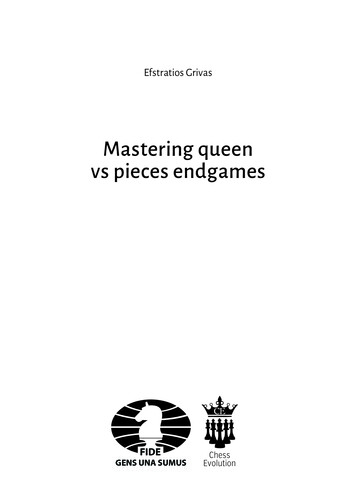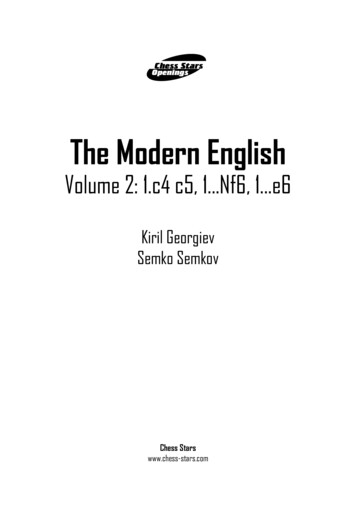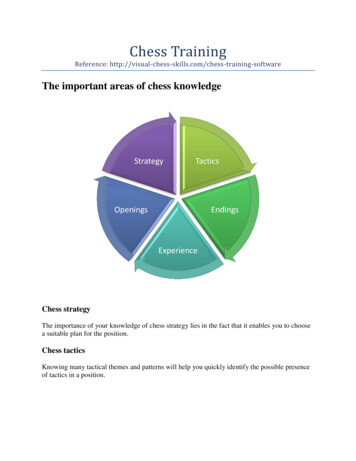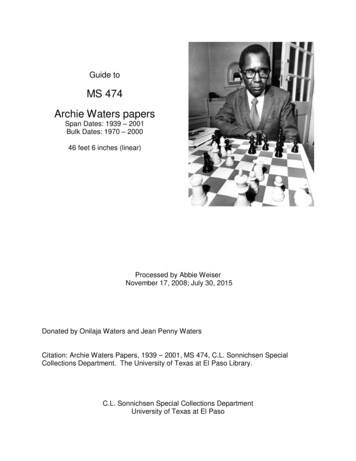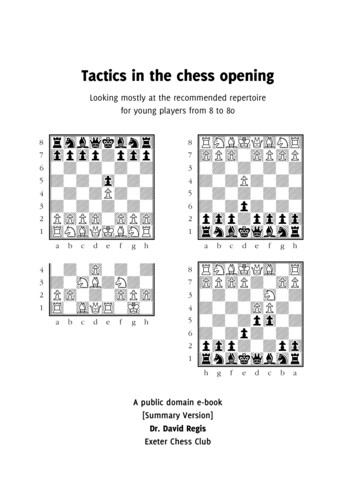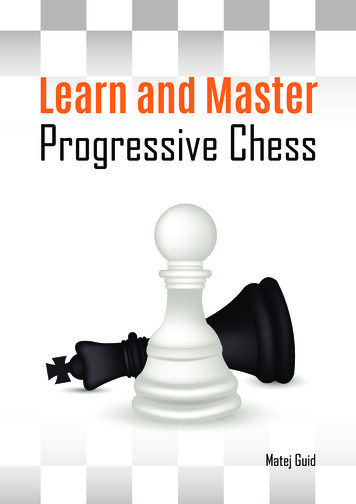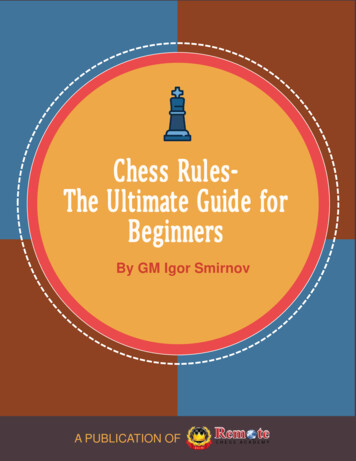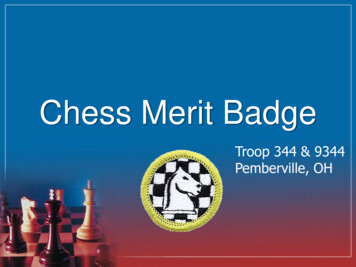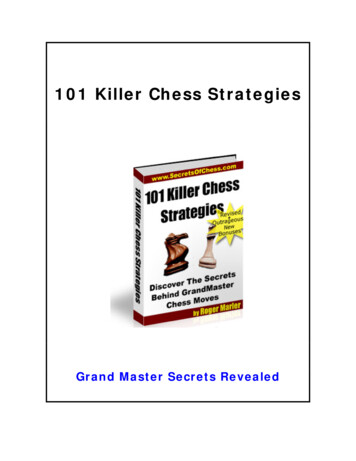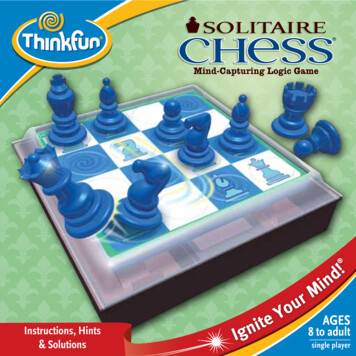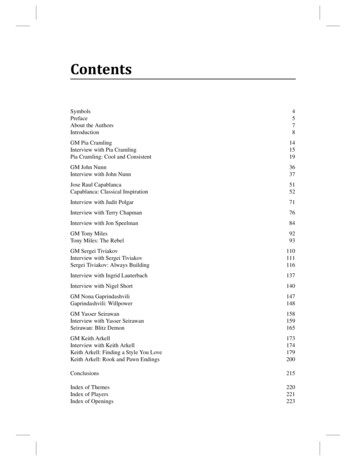
Transcription
ONTENTSContentsSymbolsPrefaceAbout the AuthorsIntroduction4578GM Pia CramlingInterview with Pia CramlingPia Cramling: Cool and Consistent141519GM John NunnInterview with John Nunn3637Jose Raul CapablancaCapablanca: Classical Inspiration5152Interview with Judit Polgar71Interview with Terry Chapman76Interview with Jon Speelman84GM Tony MilesTony Miles: The Rebel9293GM Sergei TiviakovInterview with Sergei TiviakovSergei Tiviakov: Always Building110111116Interview with Ingrid Lauterbach137Interview with Nigel Short140GM Nona GaprindashviliGaprindashvili: Willpower147148GM Yasser SeirawanInterview with Yasser SeirawanSeirawan: Blitz Demon158159165GM Keith ArkellInterview with Keith ArkellKeith Arkell: Finding a Style You LoveKeith Arkell: Rook and Pawn Endings173174179200Conclusions215Index of ThemesIndex of PlayersIndex of Openings220221223
YASSER SEIRAWANGM Yasser SeirawanDate of birth: 23th March 1960Place of birth: Damascus, SyriaHighest Elo: 2658 (age 51)Quote:“My style is based around provocation and counter-punches. I like waving a red flag at the opponent!”Career highlights include:World Junior Champion 19794-times US ChampionDutch Open Blitz Champion 2011 and 2012Publications include:‘Winning Chess’ seriesChess Duels: My Games with the World Champions, 2010
Interview with Yasser SeirawanGM Yasser Seirawan grew up in America, learnt chess at age 12 and became World Junior Champion at the age of 19. Yasser was long-time editor of Inside Chess magazine and is a popular chesscommentator including for the Chess24 website. In this interview, given at the 2015 Tata Steel tournament in Wijk aan Zee, Yasser describes how chess has changed during his lifetime and illustratesthis with some interesting games.How did your chess comebackin 2011 come about?I put myself in self-mate! In 2003I announced my retirement fromchess. Chess was in trouble as wedidn’t have a unified chess world.For the next few years I played justDutch League but no tournamentchess.Around 2011 I was very impressedby what the St Louis Chess Clubhad done for US chess. Before, thecentre of US Chess had always beenManhattan. The idea that in 2011the centre of the US chess scene hadmoved from Manhattan to Missouriwas as random as. a world chesschampion from Norway! The StLouis Chess Club had rescued theUS Championship, which now wasa professional event with an excellent prize fund. I wrote a nice emailto the directors thanking them onPhotograph by Natasha Reganbehalf of chess grandmasters forwhat they had achieved, saying Ihoped one day to thank them in person.That was the self-mate. I straightaway got an email back saying we accept your invitation, pleasecome and play and tell us what you think!I played in the US Championship and it felt strange, like everything was wrong. The first problem was my jetlag in round 1 against Christiansen. I was seeing ghosts, getting mixed up andplayed an awful game.I soon realized my openings were really poor. I had never been great at openings – they were always a bit soft you could say, no topical Grünfelds or Sicilians – I just wanted positions to play. At theUS Championship all these guys were preparing well beyond me. This also affected my clock handling. In my career I had never been afflicted by time-trouble but here I was always behind on time.On the plus side, however, the longer the games went on, the better I felt. I was warming up!
160CHESS FOR LIFEYasser Seirawan – Ray RobsonUSA Ch, Saint Louis 20121 c4 Ìf6 2 Ìc3 g6 3 g3 d5 4 cxd5 Ìxd5 5 Íg2 Ìxc3 6 bxc3 Íg7 7 Îb1 Ìd7 8 c4 0-0 9 Ìf3c5 10 0-0 Îb8 11 d3 b6 12 Íb2 Íxb2 13 Îxb2 Íb7 14 Ëd2 Ëc7 15 Ëf4 Ëxf4 16 gxf4 Íxf3 17Íxf3 (D)B-t- -tk z- nzp p-z- - p -z- - - P -Z- - P L PT- PZ-Z - - RM-The position is pretty equal out of the opening. Now Yasser starts to get into his stride!17.Îfc8 18 Êg2 e6 19 a4 a5 20 Îfb1 Êf8 21 Êf1 Êe7 22 Êe1 Êd6 23 Êd2 Êc7 24 e3 h6 25h4 Îg8 26 Îg1 h5 27 d4 cxd4 28 exd4 Êd6 29 Êc3 Îgc8 30 Îgb1 Êe7 31 Êd3 Îd8 32 Íc6(D)B-t-t- - - nmp -zL p p z- - - pP PZ-Z-Z - K - -T- -Z- R - - -32.Êf6 33 Íxd7 Îxd7 34 Îxb6 Îbd8 35 d5 Êf5 36 Îb7 Êxf4 37 Îxd7 Îxd7 38 Êd4 g5 39hxg5 h4 40 Îb8 Êxg5 41 Êe5 exd5 42 Îg8 Êh5 43 cxd5 h3 44 d6 f6 45 Êe6 Îh7 46 Îg1 Êh447 Îh1 Êg4 48 d7 Îh8 49 Êxf6 1-0Sadly the US championship ended at just the wrong moment for me. I was warmed up!I went back to my peaceful retirement world and then received an email inviting me to the WorldTeam Championship. I replied saying they had the wrong person; I had not played enough games toeven meet the activity criteria for selection so I wasn’t even qualified to play. It turned out I wasqualified but did I want to go? In the end friendships swung it. My colleagues insisted they reallywanted me to go – Gata Kamsky was especially persuasive.One of my best friends, John Donaldson, was captain. What does a best friend do? Start me offwith three blacks in a row! It all turned out fine though.How is it to play chess nowadays as an experienced player?There was a tournament in Amsterdam with seniors against juniors. Whilst the youngsters werewinning the games, the professors were winning the post-mortems. Ljubojevi‡ was brilliant at
YASSER SEIRAWAN161post-mortems. He would always give strong opinions, though would sometimes change his mind acouple of minutes later.Youngsters tend to be strong at analysing and their openings are better, the older have a good positional understanding as the games progresses.Do you think that some players adapt better than others to long playing careers?Walter Browne would beat me in my teenage years (6 losses and 1 draw). In later years I began to improve my score. My god what a calculator he was! He would analyse a position to thenth degree, well beyond my horizon, and to a definitive purpose (he calculated until the positionwas clear). He was like a volcano at the board, always intense and perpetually in time-trouble. Ithought that one day he must burn himself out. And that did happen as he had a decline in hismid-40s.Conversely Anatoly Karpov is a scary player. Why? His intuition is flawless. Strategically he isso gifted. Pairing that talent with a really good opening repertoire made him World Champion. Ithought this guy would remain the world champion for 40 years!I think of Garry Kasparov as the best player of all time but we tend to forget that in 1984 Karpov was leading 5-0 against him. If it had gone to 6-0 Kasparov may never have recovered. As itwas, it ended up derailing Karpov. Garry was still at his peak in 2005 when he stepped away fromchess. Garry had been a calculator like Walter Browne. A meteor-like force who defied gravity!How does chess work now compare with your time as a full-time professional?I’ve done some work with two young players, Daniel Naroditsky and Wesley So.Naroditsky is a child of the digital age. It is extraordinary for me to watch his use of computersand how he manages to absorb so much information.Wesley So also has a great knowledge of how to make use of computers. I always thought ofchess as pattern-recognition. The more patterns you are aware of, the more quickly ideas come toyou. When working with a computer on the 2D screen, somehow these patterns are very apparent.Players can assimilate this information at a very rapid rate. Sometimes I see Nakamura looking upinto the air during the opening phase, and it seems to me as if he’s replaying clicking on the screenin his head!I was helping Wesley to prepare for a tournament via Skype and trying to trick him in a positionof which I had very deep knowledge. I gave him a position and said I was not interested in calculation but wanted him to find and describe ideas. He did that – and very well – but then 15 minutesinto the 1-hour lesson, he also gave me a precise calculation line to resolve the position!How would you describe your own playing style?My style is based around provocation and counter-punches. I like waving a red flag at the opponent!Which players have influenced you?My style isn’t exactly modelled on Korchnoi or Bent Larsen though these players are excellentcounter-attackers.I was impressed by Tigran Petrosian. A lot of his play clicked with me. I see myself as a prettygood strategic player, not especially an attacker but a counter-attacker.Against Tal I have a good record. It’s funny how it goes. Korchnoi remarked:Keres tended to beat Korchnoi.Tal would beat Keres.Korchnoi beat Tal.My own style worked well against Tal. He was an attacker and I knew the attack was coming, hecouldn’t contain himself and blasted open the position. I was ready for it!Tal was a long-time hero of mine. I had read and re-read his book Life and Games of Mikhail Taland his book on the 1960 World Championship match. On a first reading I just thought “Wow!” andon a second reading “I still have a lot to learn about chess”.
162CHESS FOR LIFEHow are you finding the counterattacking style these days?This style will always exist just like in boxing. Today’s chess is vastly different though from theKarpov era. Dynamic play is now dominant. When Karpov played, you couldn’t take on a disadvantage such as an isolated pawn; he would accumulate small advantages and just beat you! Dynamic play, looking for resources even when defending is in the ascendancy. Players are defendingso much better. In the old days if you got an advantage, your opponent would collapse. Today thereare fewer wipe-outs and far more titanic struggles. When I was coming back and had the advantageI had to exert myself much more than I used to.In the recent Gashimov Memorial there was a good example of the fantastic defensive mentalityof the modern players:Vladimir Kramnik – Fabiano CaruanaGashimov Memorial, Shamkir 20151 d4 Ìf6 2 Ìf3 g6 3 Íg5 Íg7 4 c3 0-0 5 Ìbd2 d5 6 e3 Ìbd7 7 Íe2 c5 8 0-0 b6 9 a4 a6 10 b4Íb7 11 a5 cxb4 12 cxb4 b5 13 Îc1 Ìe8 14 Ìb3 Ìd6 15 Ìe1 Ìc4 16 Ìd3 Îa7 17 Íh4 Ía8 18Íf3 Ìf6 19 Ëe2 Ìe8 20 g4 Ìed6 21 Íg2 Ëc8 22 Ìbc5 (D)Bl q -tk t- -zpvpp -s- p ZpSp - -ZnZ- PV - NZ- - - QZLZ -T- RM-In the old days, players understood that if Kramnik has a knight on c5 against you, then you hada duty to just collapse and lose! The modern players keep on fighting as if nothing has happened.Look what Caruana did!22.Îe8 23 Íg3 Ëd8 24 Îcd1 e6 25 f3 Ëe7 26 Êh1 Íh6 27 Ìf4 Ìb7 28 Ìcd3 Ìd8 29 e4Ìc6 30 exd5 Ìxb4 31 dxe6 Ìxd3 32 Îxd3 fxe6 33 Ëe1 Ëd8 34 h4 Îf7 35 g5 Íg7 36 Íh3 Îxf437 Íxf4 e5 38 Íg3 e4 39 Îd1 Íd5 40 Íe5 exf3 41 Ëf2 Ëxa5 42 Íg4 Îf8 43 Îd3 Ëb4 44 Íg3h5 45 gxh6 Íxh6 46 Êh2 Ìd2 47 Îa1 Ìe4 48 Ëc2 Ìxg3 49 Îxa6 Íe4 50 Íxf3 Ëe1 51 Ëb3 Êh8 52 Íxe4 Îf2 53 Êh3 Ëf1 54 Êg4 Îf4 0-1In the World Team Championships, my team captain John Donaldson gave me Black againagainst Ilya Smirin. It was a sharp line in the Caro-Kann Advance. Then the guy makes a sharpmove.I’m a pawn-grabber. Give me a pawn and I’m in heaven! Of course he had certain compensationbut darn it I thought, that is a pawn. There are only a handful of examples where I have been offereda pawn, not seen a concrete refutation, and not taken it. This time I didn’t see a refutation and didn’ttake the pawn. It was a draw.He’d been playing quickly (30-45 seconds per move). He made the sacrifice quickly. I was intimidated. Since he was still in his preparation I was influenced not to take the pawn. In the postmortem my opponent said “I’m sorry Yasser: that was a fingerfehler!” The pawn sacrifice had notbeen deliberate and I had been intimidated.
chess. Chess was in trouble as we didn’t have a unified chess world. For the next few years I played just Dutch League but no tournament chess. Around 2011 I was very impressed by what the St Louis Chess Club had done for US chess. Before, the centre of US Chess had always been Manhattan. The idea that in 2
